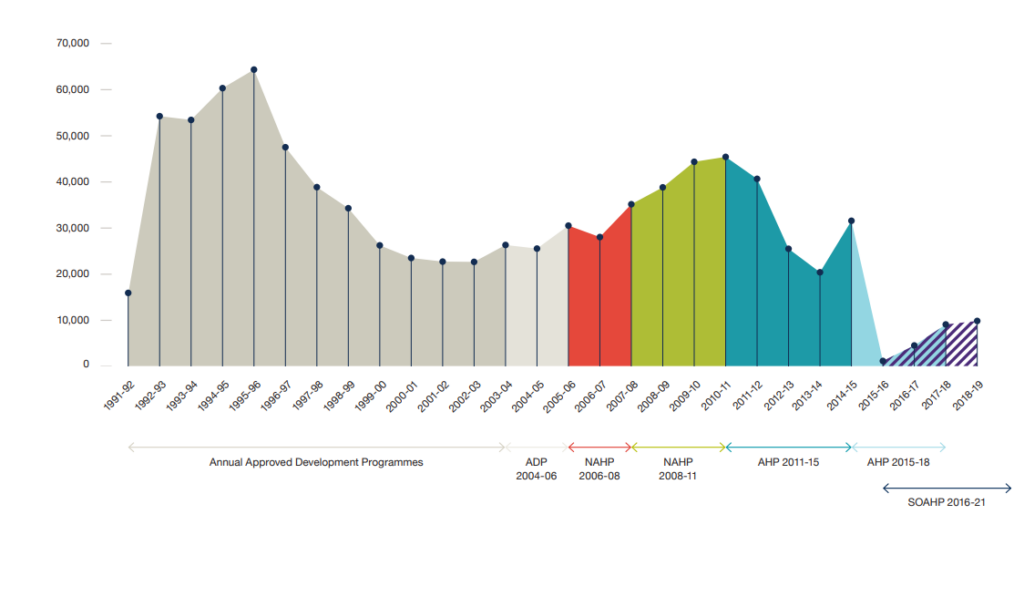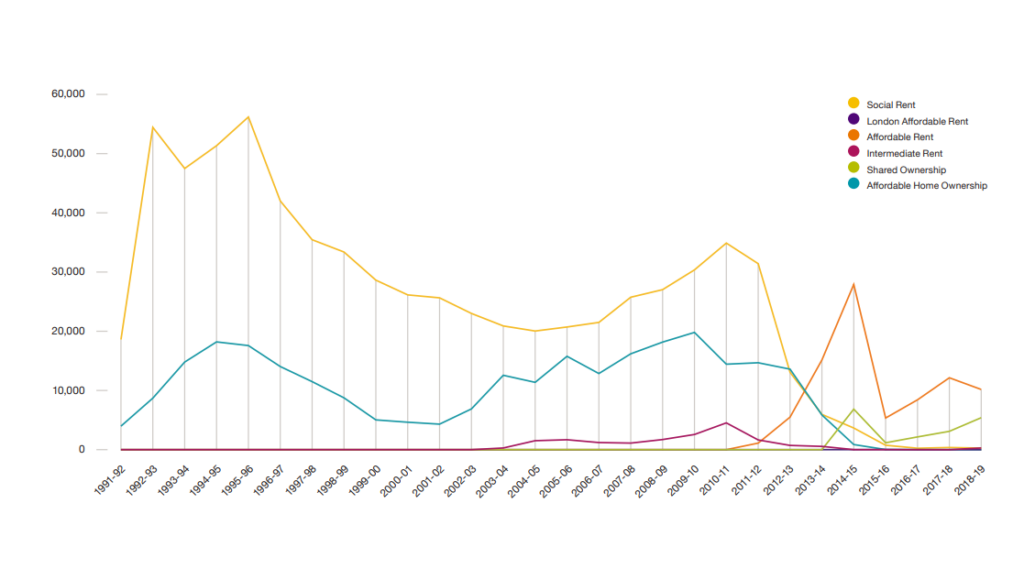Those on lowest incomes face rising costs without new provision, long-term grant funding for new homes is needed now more than ever.
The rising inequalities associated with the lack of affordable housing are becoming hard to ignore. Whether a tenant or a homeowner, housing expenses take up a large part of household’s earning each month and hence the pressure rises on political leaders to do something about it.
The latest ONS data[1] reports that “households whose income is in the bottom 10% could expect to spend more than two years of disposable income on the upfront costs of an average house in London, the South East and the East of England” and “could expect to spend more than 70% of disposable household income on mortgage repayments for an average property in England”. On the rental market, households in the bottom 25% of the income distribution could expect to pay more than 30% of their income on the cost of renting an average property.
Double or quits report highlights the need for long-term grant funding
Building housing that is affordable is not straight forward. As with other types of social infrastructure, positive externalities may be hard to capture, and this justifies government subsidies into the supply of affordable housing. Government grant is essential to incentivise the provision of affordable housing tenures.
Since the introduction of the Housing Act 1988, the Government has largely provided grant on a short-term basis, mostly aligned with the political cycle. This short-term approach to grant funding leads to high levels of uncertainty and cyclicity on the housing market. I highlight this in a recent report called Double or Quits: The influence of longer-term grant funding on affordable housing supply. It was commissioned by the Consortium of Associations in the South East (CASE)[2], The National Housing Federation[3] and Shelter.
The report finds that extending the length of capital grant, all else equal, would add certainty in the development process and reduce development cycles. This in turn may lead to more housing provision.
Grant funded affordable housing has been on a downward trend
Double or quits starts off by conducting an extensive overview of the grant arrangements and outputs over the last three decades. Up until the late 1980s, local authorities were the main provider of affordable rental accommodation, when grant for affordable housing took a downward trend[S1] .
In the last three decades, housing associations, or so-called registered providers (RPs), have been the main players in the affordable housing provision. RPs use capital grant to bridge the shortfall between the total cost of construction including private borrowing costs and revenues from the, so called, cross-subsidy[4].
The Affordable Homes Programme (AHP), which has been the primary mechanism by which Government has funded new affordable homes since 2011, has provided funding on a three- to five-year basis. Table 1 shows the various capital grant schemes available since 1991. Each colour represents a grant cycle – from the beginning of the grant to its expiry. It is clear that towards the end of each grant programme, the output increases as the grant has to be spent by the cut-off date.
Figure 1: Private Registered Providers’ Homes England / GLA funded affordable completions

Development for social rent has been on a rapid decline since 2011
Affordable housing completions can be subdivided into four main tenures, as defined by the government, social rent, affordable rent, shared ownership and intermediate rent. Figure 2 shows the affordable housing completions by tenure for England between 1991 and 2019. 2010-2011 marks an important shift in the provision of affordable housing with the introduction of a new tenure – affordable rent. Completions of social rent have rapidly declined since 2011, from around 40,000 units per year to less than 10,000.
They have been replaced by a new tenure[S2] . While the average grant per dwelling has been around £50,000 between 2006 and 2011, covering about 40% of total construction costs, it has dropped by more than half between 2011 and 2018. That led to housing associations delivering from around 50,000 social rent and shared ownership units in 2011 to less than 6,000 in 2019. The latest figures by the Ministry of Housing Communities and Local Government report total affordable housing completions of 57,185 as of the end of 2019, half of which are affordable rent.
Figure 2: Affordable Housing Completions by Tenure for England

Significant rise through developer contributions obtained through Section 106 Agreements
Since around the same time as the decline in social rent completions, most of which are delivered by housing associations, in 2011, there has been a huge rise in the share of completions associated with Section 106 (S-106) planning agreements. This is evident in Figure 3 below.
Planning obligations under Section 106 were introduced in the Town and Country Planning Act of 1990. They are ‘developer contributions’, similar to highway contributions and the Community Infrastructure Levy, partially provided for affordable housing. This means that there has been a shift in the sourcing of funds for affordable housing provision. Now, only about 50% of the funds come from the grant provided by Homes England (HE) and Greater London Authority (GLA).
The reliance on private development to deliver affordable housing through S-106 contribution has been greater than ever. This has been enabled through the substitution of social rent by affordable rent and shared ownership. The striking picture depicted in Figure 3 makes clear the direct positive relationship between affordable housing supply and market housing supply. If, following a slow-down in economic growth, development activity drops by, i.e. 30%, the provision of shared ownership and affordable rent may drop by a similar proportion, since 30% less S-106 provisions may be made.
Figure 3: Share of Completions by Tenure as Part of Section 106 (S106) Agreements

Lack of predictability of grant big issue say developing housing associations
Given the trends described above and the reliance on the market to supply affordable housing, the report goes on to investigate how increasing the length of the housing grant to 10 years could affect the provision of affordable housing by conducting structured interviews with 13 Chief Executives or development directors of housing associations.
The lack of predictability in grant provision may lead to a more cautious approach by housing associations when it comes to building their development pipelines and limit the number of affordable homes they deliver. The pronounced peaks and troughs in delivery associated with the short grant cycles, with completions skewed towards the end of Programmes, have knock-on consequences for development costs, build-quality and the productivity of the housebuilding industry.
The report finds that a ten-year Affordable Homes Programmes would enable housing associations to purchase more sites without planning permission and take on larger and more complex sites. This may lead to reducing overall construction costs and passing the savings on to the homeowners or tenants.
Land-led development by housing associations would become more prevalent
Housing associations will be more likely to invest in their in-house development teams and intensify relationships with private developers, house builders, land managers and local authorities, including through joint ventures. This can lead to consolidation on the market and economies of scale in the production of new affordable housing.
Furthermore, a move to long-term funding would also increase housing associations’ ability to fulfil deliver affordable housing counter-cyclically. It would do so by accelerating the trend for greater levels of land-led development, whereby housing associations act as the lead developer on sites rather than acquiring homes from private developers via S106.
This would enable housing associations to build up longer and more consistent pipelines of development sites, which would help avoid some of the pronounced peaks and troughs in delivery that have been associated with previous Affordable Homes Programmes.
Resilient funding provisions for affordable housing should be a high priority for Government
Due to the strong dependence of housing development on economic cycles, as outlined above, the risk of taking a market approach to affordable housing is that affordable housing supply may become more volatile and pro-cyclical.
As we are experiencing in the current Covid-19 economic downturn, having a safe and affordable place to live is a key necessity for every human being. It is in periods of downturn, that households are more likely to lose their job, become evicted and struggle to afford housing. Having a resilient provision of affordable housing, for those most in need during downturns, should be high on the priority list of the Government.
[1] Office for National Statistics (2020), https://www.ons.gov.uk/peoplepopulationandcommunity/housing/articles/alternativemeasuresofhousingaffordability/financialyearending2018.
[2] CASE is a group of 10 major housing associations providing affordable homes in the South East of England. Collectively, members own more than 400,000 homes across the country, with over 140,000 in the South East. The members of CASE are: L&Q, Metropolitan Thames Valley, Moat, Optivo, Paradigm, Radian, Sovereign Housing Association, The Guinness Partnership, The Hyde Group and West Kent Housing Association.
[3] The National Housing Federation is the voice of housing associations in England. Its members provide 2.5 million homes for 6 million people.
[4] Cross-subsidy is model in which the profits from the sale of market housing are used for the construction of affordable housing, including tenures like social rent.

